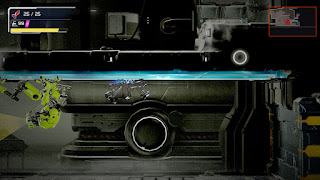Metroid Dread
I don't think 2D Metroid could be in a better place than it is right now. Thanks to the Switch's massive install base and the excellent work done by the team at MercurySteam, Metroid Dread has sold better than any other game in the series, potentially introducing tens of thousands of new players to the series. While there were a few things that kept it behind Metroid Fusion as my favorite entry, the transition to 2.5D started by Samus Returns has been fully realized here, and it's absolutely glorious. I know this kind of game won't be everyone's cup of tea, but I think Metroid Dread is exactly what we needed to make sure that people who might fall in love with the series actually get a chance to do so.
Picking up after the events of Metroid Fusion, Samus, still genetically fused with Metroid DNA, and ADAM, now integrated into the ship's computer, receive a distress signal from an unfamiliar planet. Within the distress call was an image of an x-parasite, prompting Samus to respond without hesitation. Despite her altruistic intentions, her first encounter on the planet is leaves her beaten close to death and unable to perform any of her advanced abilities. As in the rest of the series, you're now tasked with guiding Samus through an unfamiliar and unforgiving location to recover her abilities, defeat any threats, and get out safely. Dread manages to do all of this with some of the coolest surprises and epic moments in Metroid history, but it's held back by some of the worst frustrations I've encountered in the series to date.
Seeing Fusion's SA-X, Metroid Dread decided to find out what would happen if it was made it into the game's central motif. While the stealth and chase sequences were some of Fusion's most exciting and cinematic moments, I found that their drama was lost with Dread's E.M.M.I., ultimately feeling more frustrating than fun. The idea was the same, putting you in a helpless position, dreading the possibility of getting caught by an enemy you have no chance of defeating. Unfortunately, with eight E.M.M.I. scattered throughout the map, these sequences are far too frequent, and frankly, just too difficult.
These areas are meant to test your stealth abilities as you try to make it from one entrance to another without being detected. However, the E.M.M.I. always seem to spawn just a short distance away from whatever entrance you use. That, combined with their ability to hear footsteps, meant that I spent a lot more time being chased down and annihilated than actually sneaking around. When you get caught by an E.M.M.I., there's a very brief moment you have to counter it and escape, but outside of the tutorial, I only managed a successful counter once. Even if you don't dislike the E.M.M.I. encounters the way I did, they still don't do enough to differentiate themselves from one another and end up feeling very repetitive. The only upside I found was the suit upgrades you get for defeating them, which actually feeds into one of Metroid Dread's greatest strengths.
Each Metroid game is designed with a specific sequence the developers want you to find the upgrades in. You can deviate if you know the game well enough, but first playthroughs usually follow the intended path. The games preceding Dread all had very similar feeling upgrade paths that were, while somewhat predictable, both balanced and fun. Dread looked at my familiarity with this upgrade sequence and laughed, instead creating a surprisingly fresh experience. Most of Samus' most important abilities and upgrades make a return, from favorites like the space jump and screw attack to not-so-favorites like the speed booster and shinespark. The order in which they are earned is the real shocker though. I kept thinking I knew what was coming next, but I can count on one hand how many times I was actually right. This shakeup in the upgrade order, along with a small set of welcome newcomers, differentiated the feeling of progression in Dread from the rest of the series a lot more than you might expect. This delightful branching from the series' established patterns can also be seen in the game's cinematic moments.
The other Metroid game from the team at MercurySteam, Samus Returns, introduced the counter system and added cinematic fight scenes between Samus and her heftier opponents if you parry at the right moment. Metroid Dread takes it even further, and it's amazing to watch Samus bob and weave between strikes to land devastating attacks on her more fierce adversaries. That's somewhat familiar to the series already though. The bigger Metroid formula deviation comes via the addition of fully animated cut-scenes, delivering exposition, adding weight to conflicts, and conveying Samus' emotions in a way I haven't seen from the series yet. That all makes for a surprisingly impactful, and ultimately quite epic, narrative that ends up being the most memorable part of the entire game for me.
Metroid Dread has character progression and cinematics that leave its predecessors in the dust. In fact, if those darn E.M.M.I. sequences hadn't severely overstayed their welcome, I would probably say that this was the best game in the series! As it stands, it's still absolutely excellent, and I would have no trouble recommending it, even to newcomers. While I think the series is best played in order, there's a synopsis at the start that will at least catch you up to speed, and the accessibility of this entry is impossible to ignore. I'm so excited for the future of 2D Metroid after the much-deserved success of Dread, and it, along with the rest of the series, has my full recommendation.
The game is available for Switch here (as of 1/7/24): https://www.nintendo.com/us/store/products/metroid-dread-switch/




